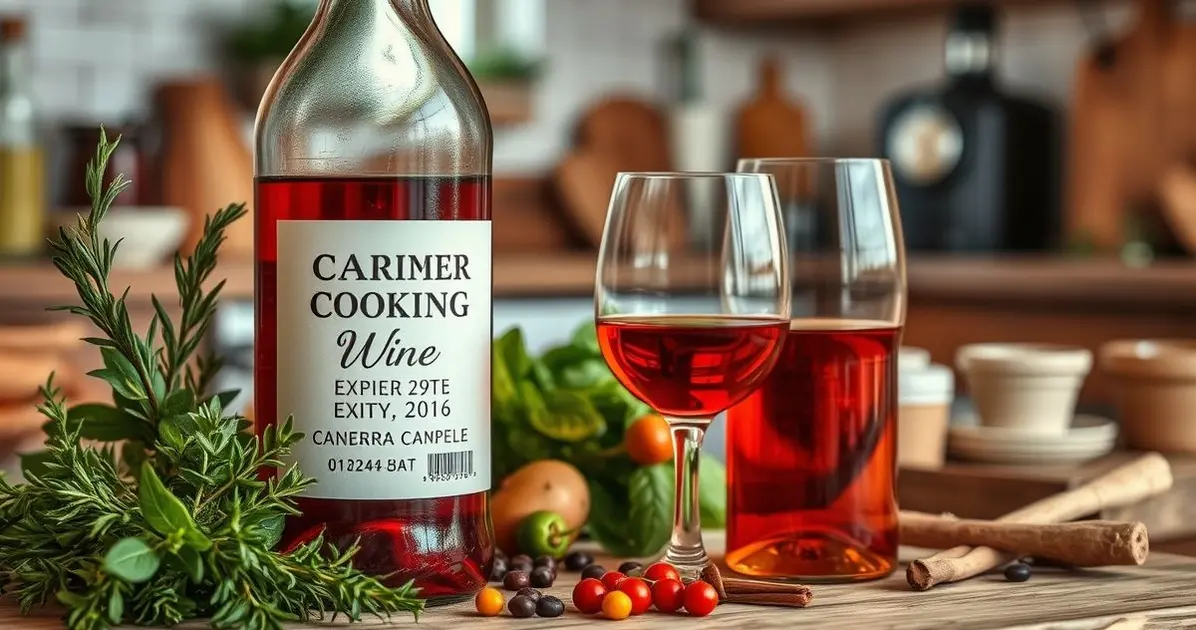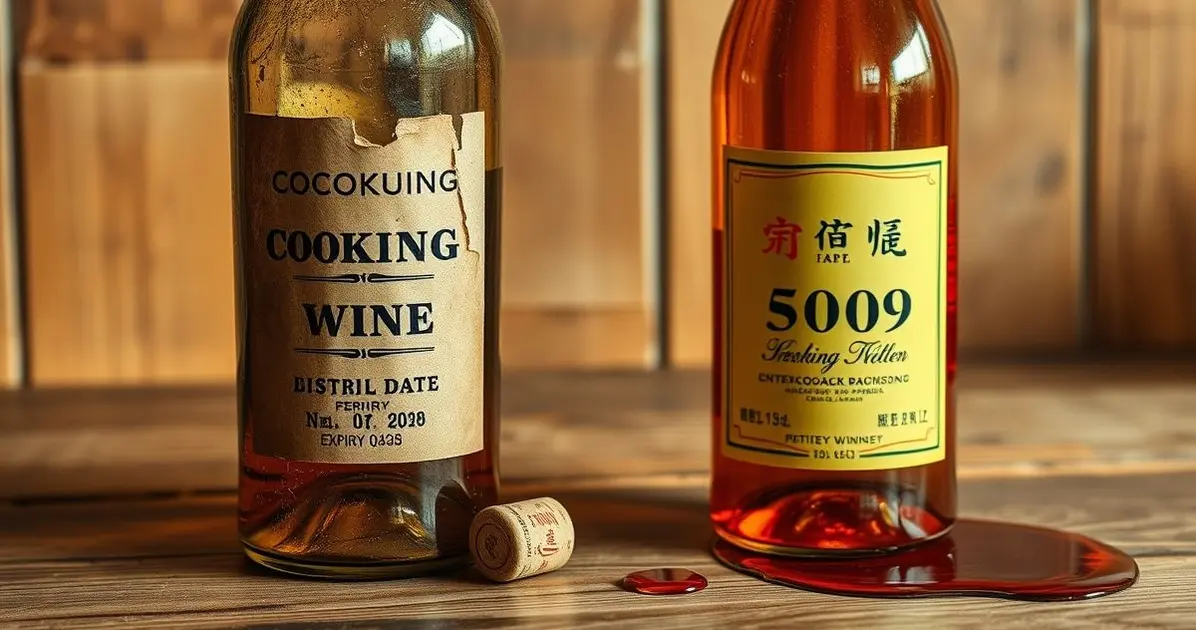Cooking wine, commonly used in various recipes, can have a shelf life. Knowing whether it goes bad is essential for food safety and flavor. It’s often cheaper than regular wine but can still spoil if not stored properly.
Can cooking wine go bad

Cooking wine can indeed go bad. When exposed to air and temperature fluctuations, it may develop off-flavors and lose its culinary qualities. Proper storage is crucial for maintaining its taste for use in your favorite dishes.
Shelf Life of Different Types of Cooking Wine
The shelf life of cooking wine can vary significantly depending on the type of wine and whether it is opened or unopened. Here’s a breakdown of the shelf life for different types of cooking wine:
1. Red Cooking Wine: Unopened red cooking wine can last for about 3 to 5 years when stored in a cool, dark place. Once opened, it is best used within 1 to 2 months for optimal flavor.
2. White Cooking Wine: Similar to red cooking wine, unopened white cooking wine can last for 3 to 5 years. After opening, it should ideally be used within 1 to 2 months. White cooking wine can sometimes spoil faster than red due to its lower acidity.
3. Specialty Cooking Wines: Specialty cooking wines, such as Marsala or sherry, can have varying shelf lives. Unopened, these wines can last for 3 to 4 years. However, once opened, they should be consumed within 1 month to maintain their unique flavors.
4. Cooking Wine with Added Ingredients: Some cooking wines have added flavors or preservatives. These may have slightly different shelf lives, but generally, they should be treated similarly to regular cooking wines. Always check the label for specific storage instructions and expiration dates.
In general, the key to maximizing the shelf life of cooking wine is proper storage. Always keep the bottles tightly sealed and store them in a cool, dark place. If you’ve opened a bottle, refrigerating it can help prolong its freshness. By understanding the shelf life of different types of cooking wine, you can ensure that you always have quality ingredients on hand for your culinary adventures.
Signs of Spoilage in Cooking Wine
Recognizing the signs of spoilage in cooking wine is essential to ensure that your culinary creations maintain their quality and flavor. Here are the key indicators that your cooking wine may have gone bad:
1. Changes in Color: One of the first signs of spoilage is a noticeable change in color. For white cooking wine, if it appears darker or has a yellowish tint, it may be a sign that it has oxidized. Similarly, red cooking wine that becomes brownish or dull can indicate spoilage.
2. Off-Putting Aroma: Fresh cooking wine should have a pleasant, fruity, or slightly acidic aroma. If you detect a sour or vinegar-like smell, this is a strong indication that the wine has spoiled and should not be used.
3. Unpleasant Taste: If the wine tastes sour, bitter, or otherwise off, it is likely past its prime. Cooking wine should enhance your dishes, not detract from them, so if the flavor is unpleasant, it’s best to discard it.
4. Sediment or Cloudiness: While some sediment can be normal in certain types of wine, excessive sediment or cloudiness can indicate spoilage. If you notice particles floating in the wine or if it appears murky, it’s a good idea to err on the side of caution and not use it.
5. Expiration Date: Always check the expiration date on the bottle. If the cooking wine is past its date, it is best to discard it, even if it appears fine. The expiration date is a good guideline for freshness.
By being aware of these signs of spoilage, you can ensure that you are using high-quality cooking wine in your dishes, enhancing their flavor and overall quality. If you notice any of these indicators, it’s best to dispose of the wine and opt for a fresh bottle to maintain the integrity of your culinary creations.

Proper Storage Tips for Cooking Wine
Proper storage of cooking wine is essential to maintain its quality and extend its shelf life. Here are some effective tips for storing cooking wine:
1. Keep it Sealed: Always ensure that the bottle is tightly sealed after each use. This helps prevent oxidation and keeps the wine fresh for a longer period.
2. Store in a Cool, Dark Place: Cooking wine should be stored in a cool, dark area away from direct sunlight and heat sources. A pantry or cupboard is ideal, as exposure to light and heat can accelerate spoilage.
3. Refrigeration After Opening: Once opened, it’s best to refrigerate cooking wine to extend its freshness. Keeping it in the fridge slows down the oxidation process and helps preserve its flavor. Ensure the bottle is properly sealed before placing it in the refrigerator.
4. Avoid Frequent Temperature Changes: Try to store cooking wine in a stable environment where temperature fluctuations are minimal. Frequent changes in temperature can negatively affect the wine’s quality.
5. Use Dark Glass Bottles: If possible, choose cooking wines that come in dark glass bottles. Dark glass helps protect the wine from light, which can degrade its quality over time.
6. Label and Date Your Wine: If you have multiple bottles of cooking wine, consider labeling them with the date of opening. This will help you keep track of freshness and ensure you use the oldest bottles first.
By following these proper storage tips, you can ensure that your cooking wine remains fresh and flavorful, ready to enhance your culinary creations whenever you need it. Taking the time to store your cooking wine correctly can prevent waste and improve the quality of your dishes.
Do You Need to Refrigerate Cooking Wine?
When it comes to storing cooking wine, a common question arises: do you need to refrigerate it? The answer largely depends on whether the cooking wine is opened or unopened.
Unopened Cooking Wine: If your cooking wine is still sealed and unopened, it does not need to be refrigerated. Unopened bottles can be stored in a cool, dark place, such as a pantry or cupboard, where they can last for several years without spoiling.
Opened Cooking Wine: Once opened, cooking wine should ideally be refrigerated. Refrigeration helps slow down the oxidation process, which can cause the wine to spoil more quickly. Keeping opened cooking wine in the fridge can extend its shelf life to about 1 to 2 months, allowing you to enjoy its flavors in your dishes for a longer period.
It’s important to tightly seal the bottle before placing it in the refrigerator to minimize exposure to air, which can also lead to spoilage.
Specialty Cooking Wines: Specialty cooking wines, such as Marsala or sherry, also benefit from refrigeration after opening. These wines may have slightly different storage requirements, so always check the label for specific recommendations.
In summary, while unopened cooking wine can be stored at room temperature, it is best to refrigerate opened cooking wine to maintain its quality and flavor. By following these guidelines, you can ensure that your cooking wine remains fresh and ready for your culinary adventures.
Conclusion
In conclusion, understanding whether cooking wine can go bad is essential for maintaining the quality of your culinary creations.
Cooking wine, like any other ingredient, has a shelf life that varies depending on its type and storage methods.
By recognizing the signs of spoilage, such as changes in color, aroma, and flavor, you can avoid using wine that may compromise your dishes.
Proper storage techniques, including keeping the wine sealed, storing it in a cool, dark place, and refrigerating after opening, can significantly extend its freshness and usability.
Ultimately, whether you’re using red, white, or specialty cooking wine, being mindful of its storage and shelf life will help you make the most of this versatile ingredient.
With these tips, you can ensure that your cooking wine enhances your meals without any waste, allowing your culinary skills to shine.
FAQ – Frequently Asked Questions about Cooking Wine
Can cooking wine go bad?
Yes, cooking wine can go bad, especially after it has been opened. Signs of spoilage include changes in color, aroma, and flavor.
How long does cooking wine last once opened?
Once opened, cooking wine should ideally be used within 1 to 2 months for the best quality.
Do I need to refrigerate cooking wine?
Yes, opened cooking wine should be refrigerated to extend its freshness, while unopened bottles can be stored at room temperature.
What are the signs of spoilage in cooking wine?
Signs of spoilage include changes in color, an off-putting aroma, unpleasant taste, and excessive sediment or cloudiness.
How should cooking wine be stored?
Cooking wine should be stored in a cool, dark place, tightly sealed, and refrigerated after opening to maintain its quality.
What is the shelf life of different types of cooking wine?
Unopened cooking wine can last 3 to 5 years, while opened cooking wine should be consumed within 1 to 2 months.
See more
Discover plenty of easy and delicious recipes you can make at home, from hearty dinners to indulgent desserts and wholesome breakfasts.




